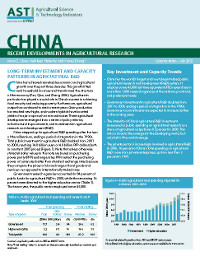Authors:
Chen, Kevin Z.; Flaherty, Kathleen; Zhang, Yumei
Year:
2012
Publisher
International Food Policy Research Institute (IFPRI)
Back to:
After three decades of reform, agricultural R&D in China has made considerable progress. Total public expenditures on agricultural R&D doubled from 2001 to 2008, and private expenditure on agricultural R&D grew at an even faster rate. Moreover, preliminary data for more recent years suggests that investments have continued to rise. Furthermore, the government’s recently released 2012 Number 1 document indicates that agricultural technology remains high on the policy agenda (Huang 2012).
Policy reforms have contributed greatly to the increased public and private investment. Measures have strengthened the patent system and diversified R&D funding sources by introducing commercialization and competition. Agricultural researcher qualifications have risen as well. The share of scientists and engineers holding a bachelor’s degree or higher is now significantly greater than in the 1980s. The productivity of government agencies has likewise improved, as evidenced by the rising number of patents and publications.
Despite the progress achieved, problems remain in China’s agricultural R&D system, and new challenges have emerged. Numerous ministries and agencies are involved in managing and conducting agricultural R&D. The resulting high level of decentralization limits coordination and has led to funding inefficiencies and duplication of research effort. In addition, due to the nature of the social welfare system, individual government institutes bear a substantial financial burden in relation to their retirees. This problem is growing as the number of retirees rises. Innovation capacity is still limited as well, and is related to the relatively small share of researchers with postgraduate degrees. Most patents are for the adaptation of technology, rather than for new inventions; investment in basic research is still very low. Finally, commercialization of research continues to present both opportunities and challenges. In China, as elsewhere, it has proven difficult to strike an appropriate balance between market-oriented research and research that meets specific developmental needs.

